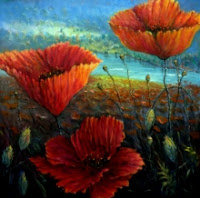 |
| Hawkesbury River near Freemans Reach 5 x 4 inches (12.7 x 10cm) Oil on Canvas. |
I didn't realise it at the time but I was only a river bend away from where Arthur Streeton in 1896 painted the iconic "The purple noon’s transparent might". I love the deep (but low chroma) blue that Streeton uses in this painting.
The Purple Noon’s Transparent Might by Arthur Streeton
123.0 x 123.0 cm
National Gallery of Victoria, Melbourne
The site is well marked now as "Streeton Lookout at Freemans Reach" overlooking the spot where Streeton painted the river. When Streeton discovered
the Hawkesbury, the river became a subject for a series of
large works. Streeton used unorthodox (for the time) shapes for his canvases and used a square one for this "panoramic" painting . He felt that he discovered "the great hidden poetry" of the Australian
landscape in the ‘glory of river and plain spread before him.
Katherine Tyrrell has an informative post on Arthur Streeton on her blog "Making a Mark", and built a new website about Streeton with links to information and online images.
Streeton, Tom Roberts, Charles Condor, Frederick McCubbin and the other Australian Impressionists are well known for their plein air painting expeditions and "camps" near Sydney and Melbourne in the mid 1800s. The National Gallery of Victoria has a good overview reference of these sites at this link
Streeton, Tom Roberts, Charles Condor, Frederick McCubbin and the other Australian Impressionists are well known for their plein air painting expeditions and "camps" near Sydney and Melbourne in the mid 1800s. The National Gallery of Victoria has a good overview reference of these sites at this link
I have recently sketched at a couple of the other Sydney sites ( Coogee and Mosman Bay) that they painted at, and they will feature in a couple of future posts.
My other blog "Painted Journey" has paintings and drawings from my second post about the painting trip to Central Australia around Alice Springs.
My other blog "Painted Journey" has paintings and drawings from my second post about the painting trip to Central Australia around Alice Springs.


















